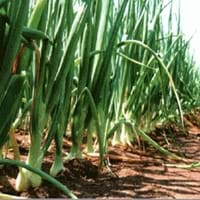Life Span
Perennial
Perennial
Type
Vegetable
Bulb or Corm or Tuber
Origin
World/Pandemic, North America, Europe, Russia/Siberia, Northern Africa, Asia, India
South America, Argentina
Types
White Spanish
Gladalan White
Not Available
Number of Varieties
Not Available
Habitat
Cropland, Farms, gardens
Temperate Regions
USDA Hardiness Zone
Not Available
5-9
AHS Heat Zone
Not Available
9-1
Sunset Zone
A1, A2, A3, H1, H2, 1a, 1b, 2a, 2b, 3a, 3b, 4, 5, 6, 7, 8, 9, 10, 11, 12, 13, 14, 15, 16, 17, 18, 19, 20, 21, 22, 23, 24
21,22
Habit
Upright/Erect
Clump-Forming
Flower Color
White, Yellow green
Light Blue, Light Purple, Silver, Sky Blue
Flower Color Modifier
Bicolor
Bicolor
Fruit Color
Not Available
Not Available
Leaf Color in Spring
Green
Green, Light Green, Gray Green
Leaf Color in Summer
Green, Gray Green
Light Green
Leaf Color in Fall
Green, Gray Green, Yellow green
Several shades of Green
Leaf Color in Winter
Not Available
Light Green
Leaf Shape
Linear
Grass like
Plant Season
Not Available
Spring
Sunlight
Full Sun, Partial Sun
Full Sun, Partial Sun, Partial shade
Type of Soil
Loam, Sand
Clay, Loam, Sand
The pH of Soil
Neutral
Acidic, Neutral, Alkaline
Soil Drainage
Well drained
Well drained
Bloom Time
Late Spring, Early Summer
Early Spring, Spring, Late Winter
Tolerances
Drought
Drought
Where to Plant?
Ground, Pot
Container, Ground
How to Plant?
Seedlings, Sets
By dividing rhizomes, tubers
Plant Maintenance
Medium
Medium
Watering Requirements
Keep the ground moist but not water-logged, Requires a lot of watering, Water twice a day in the initial period
Average Water Needs, Do Not over Water, Requires regular watering
In Summer
Lots of watering
Lots of watering
In Spring
Moderate
Moderate
In Winter
Average Water
Average Water
Soil pH
Neutral
Acidic, Neutral, Alkaline
Soil Type
Loam, Sand
Clay, Loam, Sand
Soil Drainage Capacity
Well drained
Well drained
Sun Exposure
Full Sun, Partial Sun
Full Sun, Partial Sun, Partial shade
Pruning
Dispose of diseased portions, Prune after flowering
Remove damaged leaves, Remove dead branches, Remove dead leaves
Fertilizers
14-14-14 Fertilizer, All-Purpose Liquid Fertilizer, Fertilize the soil before planting
All-Purpose Liquid Fertilizer
Pests and Diseases
Aphids, Downy mildew, Leaf rust, Slugs, Soft scales
Slugs, Snails
Plant Tolerance
Humidity, Shade areas, Shallow soil
Drought
Flower Petal Number
Single
Single
Fragrant Bark/Stem
Yes
No
Foliage Texture
Medium
Medium
Foliage Sheen
Matte
Matte
Attracts
Aphids, Insects, Snails
Bees, Birds, Hummingbirds
Allergy
Eye irritation, Gastric, Oral Allergy
Not Available
Aesthetic Uses
Not Used For Aesthetic Purpose
Showy Purposes
Beauty Benefits
Anti-ageing, Blackheads, Good for the Scalp, Reduce Bruises
Not Available
Environmental Uses
Air purification, Indoor Air Purification, Insect Repellent
Air purification
Medicinal Uses
Analgesic, Asthma, Bronchitis, cholesterol-lowering, Cough, Diabetes, Digestion problems, Diuretic, High blood pressure, Respiratory Disorders, Rheumatism
No Medicinal Use
Part of Plant Used
Whole plant
Flowers
Other Uses
Animal Feed, Culinary use, Oil is used for aromatherapy, Sauces
Not Available
Used As Indoor Plant
Yes
Yes
Used As Outdoor Plant
Yes
Yes
Garden Design
Edible, Herb / Vegetable
Container, Lawns and Turf, Mixed Border, Rock Garden / Wall, Wildflower
Botanical Name
ALLIUM cepa 'White Ebenezer'
Ipheion uniflorum
Common Name
Garden Onion, White Onion
Spring Starflower, Springstar
In Hindi
प्याज
Spring Starflower
In German
Zwiebel
Frühling Borretsch
In French
Oignon
Spring Starflower
In Spanish
Cebolla
primavera Flor de estrella
In Greek
Κρεμμύδι
άνοιξη starflower
In Portuguese
Cebola
primavera Starflower
In Polish
Cebula
Wiosna Starflower
In Latin
cepa
Spring Starflower
Phylum
Magnoliophyta
Magnoliophyta
Class
Liliopsida
Lilopsida
Order
Asparagales
Asparagales
Family
Liliaceae
Liliaceae
Clade
Angiosperms, Monocots
Angiosperms, Monocots
Tribe
Allieae
Gilliesieae
Subfamily
Allioideae
Allioideae
Number of Species
Not Available
Importance of White Onion and Spring Starflower
Want to have the most appropriate plant for your garden? You might want to know the importance of White Onion and Spring Starflower. Basically, these two plants vary in many aspects. Compare White Onion and Spring Starflower as they differ in many characteristics such as their life, care, benefits, facts, etc. Every gardener must at least have the slightest clue about the plants he wants to plant in his garden. Compare their benefits, which differ in many ways like facts and uses. The medicinal use of White Onion is Analgesic, Asthma, Bronchitis, cholesterol-lowering, Cough, Diabetes, Digestion problems, Diuretic, High blood pressure, Respiratory Disorders and Rheumatism whereas of Spring Starflower is No Medicinal Use. White Onion has beauty benefits as follows: Anti-ageing, Blackheads, Good for the Scalp and Reduce Bruises while Spring Starflower has beauty benefits as follows: Anti-ageing, Blackheads, Good for the Scalp and Reduce Bruises.
Compare Facts of White Onion vs Spring Starflower
How to choose the best garden plant for your garden depending upon its facts? Here garden plant comparison will help you to solve this query. Compare the facts of White Onion vs Spring Starflower and know which one to choose. As garden plants have benefits and other uses, allergy is also a major drawback of plants for some people. Allergic reactions of White Onion are Eye irritation, Gastric and Oral Allergy whereas of Spring Starflower have Not Available respectively. Having a fruit bearing plant in your garden can be a plus point of your garden. White Onion has no showy fruits and Spring Starflower has no showy fruits. Also White Onion is not flowering and Spring Starflower is not flowering . You can compare White Onion and Spring Starflower facts and facts of other plants too.





